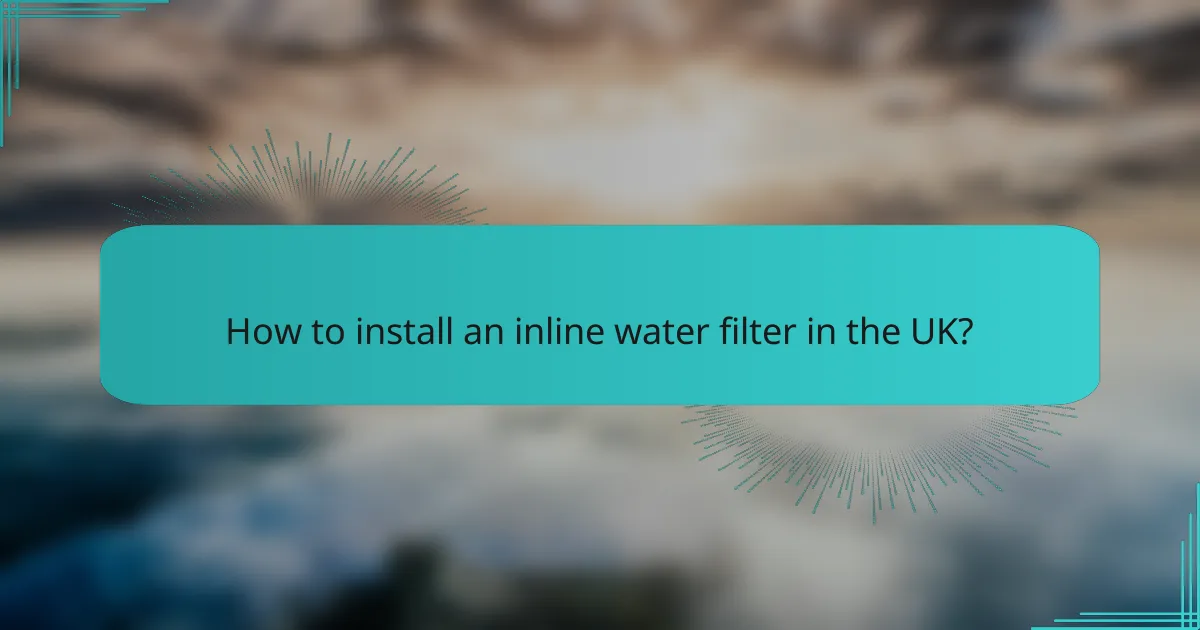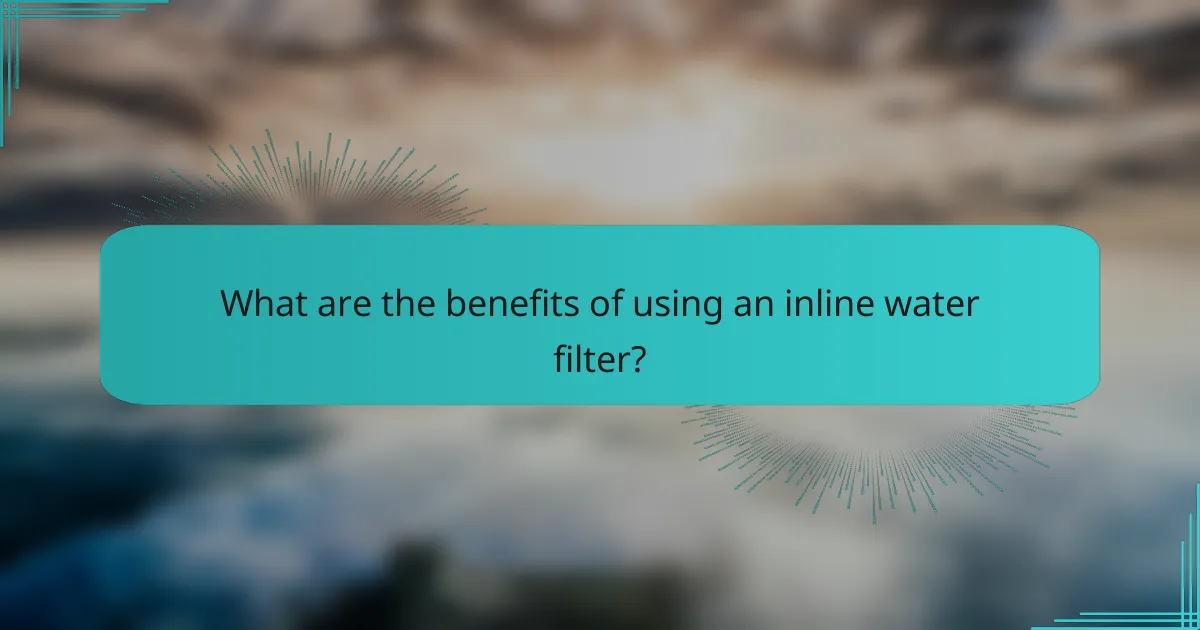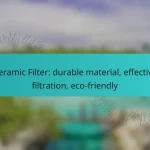Installing an inline water filter can significantly enhance your water quality by connecting it directly to your existing plumbing, usually under the sink. These filters typically last between six months to two years, depending on usage and water quality, making regular maintenance crucial for optimal performance. When selecting a filter, ensure it is compatible with UK plumbing standards for a seamless installation and effective filtration.

How to install an inline water filter in the UK?
Installing an inline water filter in the UK involves connecting the filter directly to your existing plumbing system, typically under the sink. This process can improve water quality by reducing contaminants and ensuring cleaner drinking water.
Step-by-step installation guide
Begin by turning off the water supply to avoid leaks. Next, locate the cold water line and cut it to insert the filter. Use the provided fittings to connect the filter securely, ensuring there are no gaps that could lead to leaks.
After connecting the filter, turn the water supply back on and check for any leaks. Once confirmed, flush the filter according to the manufacturer’s instructions to remove any carbon dust before use.
Tools required for installation
To install an inline water filter, you will need a few basic tools. A pipe cutter or hacksaw is essential for cutting the water line, while adjustable wrenches will help tighten the fittings securely.
Additionally, having plumber’s tape on hand can help create a watertight seal, preventing leaks at the connections. A bucket may also be useful to catch any water that spills during the installation process.
Common installation mistakes
One common mistake is failing to turn off the water supply before starting the installation, which can lead to a messy situation. Another frequent error is not using plumber’s tape, which can result in leaks at the connections.
Ensure that the filter is installed in the correct direction, as indicated by the arrows on the unit. Installing it backward can affect its performance and filtration efficiency.

What is the lifespan of an inline water filter?
The lifespan of an inline water filter typically ranges from six months to two years, depending on usage and water quality. Regular maintenance and timely replacements are essential to ensure optimal performance and water safety.
Average filter lifespan in years
Most inline water filters last between one to two years under normal conditions. However, some high-capacity filters may extend beyond two years if maintained properly. It’s advisable to check the manufacturer’s guidelines for specific recommendations.
Factors affecting filter lifespan
Several factors can influence the lifespan of an inline water filter, including water quality, usage frequency, and the type of contaminants present. For instance, filters in areas with hard water or high sediment levels may require more frequent replacements.
Additionally, the volume of water filtered daily plays a significant role. Filters used in households with high water consumption will generally need to be replaced sooner than those in less demanding environments. Regular monitoring and timely changes can help maintain water quality and filter efficiency.

Which inline water filters are compatible with UK plumbing?
Inline water filters that are compatible with UK plumbing typically feature standard connection sizes and fittings, allowing for easy integration into existing systems. Look for filters that specify compatibility with UK plumbing standards to ensure proper installation and performance.
Popular brands compatible with UK plumbing
Several well-known brands offer inline water filters that work seamlessly with UK plumbing. Brands like Brita, AquaCrest, and Waterdrop provide filters designed to fit standard UK pipe sizes and connections. These filters often come with clear installation instructions tailored for UK homeowners.
When selecting a brand, consider the specific filtration needs, such as removing chlorine, lead, or sediment. Checking customer reviews can also help gauge reliability and effectiveness.
Compatibility with different plumbing systems
UK plumbing systems vary, with most homes using either a gravity-fed or pressurized system. Inline water filters must be compatible with the system in use, ensuring adequate water flow and pressure. For gravity-fed systems, filters should be positioned to maintain optimal water flow without creating blockages.
Before installation, verify the filter’s specifications, including connection types (e.g., push-fit or threaded) and size (typically 15mm or 22mm). This ensures that the filter integrates well with your existing plumbing setup without the need for extensive modifications.

What are the benefits of using an inline water filter?
Using an inline water filter significantly enhances the quality of drinking water by removing impurities and contaminants. This leads to safer, better-tasting water directly from your tap, making it a practical choice for households.
Improved water quality
Inline water filters work by utilizing various filtration technologies, such as activated carbon and reverse osmosis, to eliminate harmful substances like chlorine, lead, and sediment. This results in cleaner, healthier water that can improve the taste and odor.
Regular maintenance and timely replacement of filters are crucial to ensure optimal performance. Most inline filters can last several months to a few years, depending on usage and water quality, so monitoring their condition is essential.
Cost-effectiveness over time
Investing in an inline water filter can lead to significant savings compared to purchasing bottled water. The initial setup cost is often recouped within months, as filtered tap water is much cheaper than bottled alternatives.
Consider the long-term benefits: while the upfront cost may vary, the ongoing expenses for filter replacements are generally low, making it a budget-friendly solution for clean drinking water. Regularly checking for compatibility with existing plumbing can further enhance cost-effectiveness by avoiding additional installation fees.

How to choose the right inline water filter?
Choosing the right inline water filter involves assessing your water quality, filter lifespan, and compatibility with your existing plumbing. Consider factors such as the contaminants you want to remove, the filter’s capacity, and whether it fits your current setup.
Key features to consider
When selecting an inline water filter, focus on filtration efficiency, flow rate, and maintenance requirements. Look for filters that meet NSF/ANSI standards for contaminant removal, ensuring they effectively eliminate impurities like chlorine, lead, and sediment.
Additionally, consider the filter’s lifespan, typically ranging from six months to two years, depending on usage and water quality. A longer lifespan can reduce maintenance frequency and costs.
Compatibility with your plumbing is crucial; ensure the filter can connect to your existing pipes or fixtures without requiring extensive modifications. Check the size and type of fittings to avoid installation issues.
Comparison of top models
When comparing top inline water filters, consider models like the APEC Water Systems RO-CTOP and the iSpring RCC7AK. The APEC model is known for its high filtration capacity and efficiency, while the iSpring offers a balanced approach with added alkaline filtration for taste enhancement.
Both models typically feature easy installation processes and are compatible with standard plumbing setups. Prices can vary, with options generally ranging from $50 to $200, depending on features and brand reputation.
Read customer reviews and check for warranty options to ensure you choose a reliable filter that meets your specific needs. A good warranty can provide peace of mind regarding the product’s durability and performance.

What maintenance is required for inline water filters?
Inline water filters require regular maintenance to ensure optimal performance and water quality. This includes periodic replacement of the filter cartridge and monitoring for any signs of reduced flow or contamination.
Regular maintenance tasks
To maintain an inline water filter, check the manufacturer’s guidelines for recommended filter replacement intervals, typically every 6 to 12 months. Regularly inspect the filter for leaks or damage, and clean any accessible components to prevent buildup of sediment or contaminants.
Additionally, flushing the system with clean water after changing the filter can help remove any residual particles. Keeping a maintenance log can also assist in tracking replacement dates and any issues that arise.
Signs that maintenance is needed
Common signs that your inline water filter requires maintenance include a noticeable decrease in water flow or pressure, unusual tastes or odors in the water, and visible discoloration or sediment. If you experience any of these issues, it’s advisable to check the filter immediately.
Other indicators may include a warning light on the filtration system, if applicable, or an increase in the frequency of filter changes. Regularly monitoring these signs can help prevent more significant water quality issues and ensure your system operates efficiently.

What are the emerging trends in inline water filtration?
Emerging trends in inline water filtration focus on enhanced efficiency, sustainability, and user-friendly designs. Innovations include advanced filtration technologies, smart monitoring systems, and eco-friendly materials that cater to growing health and environmental concerns.
Installation process
The installation process for inline water filters typically involves connecting the filter directly to your existing plumbing. Most systems require minimal tools and can be completed in under an hour, making them accessible for DIY enthusiasts.
Start by shutting off the water supply and draining the pipes. Then, follow the manufacturer’s instructions to cut the pipe and insert the filter, ensuring secure connections to prevent leaks. It’s advisable to check local plumbing codes to ensure compliance.
Filter lifespan
The lifespan of an inline water filter generally ranges from six months to two years, depending on water quality and usage. Regular monitoring and timely replacements are crucial to maintain optimal filtration performance.
Many filters come with indicators or guidelines to help users track when a replacement is necessary. Factors such as sediment levels and water hardness can significantly impact how long a filter lasts, so consider these when selecting a system.
Compatibility with existing plumbing
Most inline water filters are designed to be compatible with standard plumbing systems, but it’s essential to check specifications before purchase. Look for filters that fit the diameter of your pipes and match the water flow rate.
Some filters may require additional fittings or adapters for installation, especially in older homes with unique plumbing configurations. Consulting with a professional can help ensure compatibility and prevent installation issues.


